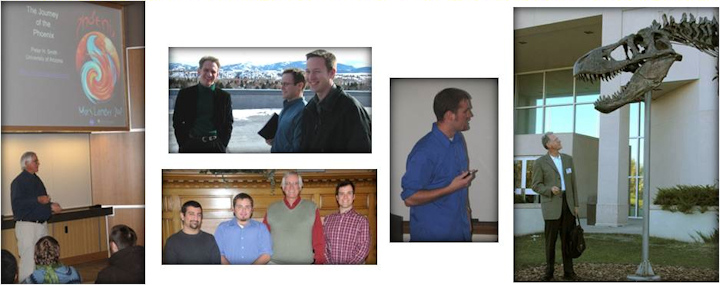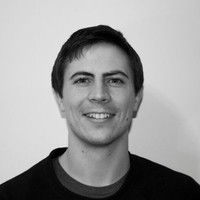OpTeC Colloquium
OpTeC sponsors a colloquium throughout the academic year. This is a forum where a wide range of optical science and engineering topics are discussed at a level that can be understood by a broad spectrum of optics students, staff, and faculty. The primary purposes are to train students to give effective scientific talks and to promote cross-disciplinary interactions of students, staff, faculty, and local industry employees. Speakers include MSU students, staff, and faculty, and visitors from external universities, research labs, and companies.
December 4, 2025
4:10 pm
Norm Asbjornson Hall
Room 149
on the Montana State Univeristy Campus
Click here to join via WebEx
Download the flyer here
|
|
Nick Holom
|
Montana’s Photonics Workforce Roadmap: Preparing for Growth and Scale
Abstract
Montana’s photonics industry is at an inflection point, moving from a research-focused cluster toward scalable manufacturing. This presentation offers a preview of preliminary results from the Montana Photonics Workforce Roadmap, highlighting 10-year growth scenarios and the roles most in demand. While the current talent base is strongest in engineering and software development, scaling will require a larger pipeline of technicians, machinists, assemblers, quality staff, and frontline supervisors. I will outline priority pathways and concrete examples to better align education and training with employer needs.
Biographical Sketch
Nick Holom is a Senior Economist with the Montana Department of Labor & Industry, where he analyzes workforce trends, training pipelines, and industry demand. Nick’s work blends labor market data, forecasting, and program evaluation to support policy and industry decisions. His current projects focus on photonics and advanced manufacturing, as well as forecasting labor force trends and creating tools that make complex labor trends actionable for practitioners.
Past Speakers
| Date | Speaker | Group | Summary |
|---|---|---|---|
| 11/20/2025 |
Farshina Nazrul Shimim |
Precision Agriculture Montana State University |
From Satellites to Soil: ML-driven Daily Crop Water Predictions |
| 7/10/2025 |
Jenn Cable |
Thorlabs, Inc. |
A view inside a leading photonics industry player: Learn how a career in the photonics industry can be fullfilling and fun |
| 6/30/2025 |
Trent Berg |
Aurora |
A Montana Story: Farming to Photonics |
| 5/1/2025 |
Tomasz S. Tkaczyk |
Rice University |
Development of the next generation of biophotonic/photonic imaging systems |
| 2/20/2025 |
Meredith Kupinski |
University of Arizona |
Tracking the sky's neutral point positions for atmospheric turbidity |
| 1/23/2025 |
Andrew Oliver |
Montana State University |
Productization: Peeling the Onion or How to design and build millions of high-quality devices |
| 10/24/2024 |
Patrick Franzen |
SPIE |
Scholarly Publishing in 2024: A publisher's perspective |
| 9/12/2024 |
Jed Hancock |
Space Dynamics Laboratory, Utah State University |
Exploring Atmospheric Gravity Waves: NASA's Atmospheric Waves Experiment on the International Space Station |
| 6/13/2024 |
Matthew Birkebk |
Labsphere |
Fundamental Calibrations for Remote |
| 11/30/2023 |
Stefan Heinemann |
Phix, North America |
Packaging technologies of integrated photonics for quantum technology |
| 4/27/2023 |
Allison Barto |
Ball Aerospace |
Engineering Discovery: Building NASA's James Webb Space Telescope |
| 3/30/2023 |
Thomas Coleman |
Silixa, LLC |
Fiber optic distributed sensing for environmental and infrastructure monitoring |
| 3/23/2023 |
John Howell |
Chapman University |
Doppler Gyroscopes: Do we really understand the gyroscope? |
| 2/16/2023 |
Krishna Rupavatharam, Ph.D. |
Spectrum Lab |
Perspectives on the evolution of microwave and quantum photonics at Spectrum Lab |
| 2/9/2023 |
John W. Sheppard, Ph.D., FIEE |
MSU Gianforte School of Computing |
Demystifying machine learning through eXplainable AI |
| 1/26/2023 |
Finland Photonics |
Finnish Photonics Cluster |
Photonics in Finland |
| 12/8/2022 |
Nicholas Borys. Ph.D. |
MSU Physics |
An introduction to the MonArk NSF Quantum Foundry |
| 10/12/2022 |
Alex Hills |
Carnegie Mellon University |
Mitigating LEO-to-GEO satellite interference |
| 4/14/2022 |
Stephen Schultz |
Brigham Young University, Electrical & computer Engineering |
Dynamic measurement of soft body armor using optical fiber sensing |
| 3/31/2022 |
Bradley Whitaker |
MSU Electrical & Computer Engineering |
How machine learning can help scientists who shoot fish and insects with lasers |
| 2/24/2022 |
Tom Hausekn |
Optica |
Hot topics in optics and photonics |
| 2/25/2021 |
Jim Webb1 & Scott Wohlstein2 |
1 G.L. Services, Hertfordshire, England |
Using the LaserSafePC software for laser safety calculations |
| 2/4/2021 |
Brian D'Urso |
MSU Physics Department |
Towards precision pulsed levitated optomechanics in a magneto-gravitational trap |
| 1/21/2021 |
Wataru Nakagawa |
MSU ECE Department |
Nanophotonics Applications and Sabbatical Exploration |
| 1/14/2021 |
Nathan Kuehl Bryan Scherrer |
MSU Physics and ECE Dep'ts | Kuehl: Troubleshooting, repair and calibration of Burleigh WA-1500 Wavemeter. Scherrer: Model and simulation of wing-beat modulation lidar for making 3D maps of flying insects . VIDEO |
| 11/19/2020 | Dr. Charles Kankelborg | MSU Physics Department |
Designing a far ultraviolet spectrometer for the sun as a starAbstract |
| 11/12/2020 | Dr. Ioannis Roudis | MSU ECE Department | Nonlinear noise in coherent optical communications systems Abstract |
| 4/09/2015 | Dr. James G. Wessel | Seagate Corporation | Hard Disc-Drive Recording |
| 3/19/2015 | Dr. Jake Jacobsen | Synopsys, Optical Solution Group | A review of optical design software at Synopsys |
| 2/05/2015 | Dr. Mark A. Wistey | ECE Department, University of Notre Dame | Paths to record lasers and solar cells--and on cheap silicon |
| 11/24/2014 | Dr. Olav Solgaard | ECE Department, Stanford University | Miniaturized endoscopes and implantable sensors for in-vivo studies of cancer biology |
| 11/6/2014 | Dr. Kirk Knobelspiesse | NASA Ames Research Center | Cloud thermodynamic phase detection with polarimetrically sensitive passive sky radiometers. |
| 10/30/2014 | Dr. Kris Merkel | President & CEO S2 Corporation, Bozeman, MT | S2 Extreme Bandwidth Analyzer and Correlator (EBAC):Updates on Improvements and Demonstrations |
| 11/14/2013 | Dr. Upendra Singh | NASA Langley Research Center | Development of a pulsed 2-micron integrated-path differential absorption lidar for CO2 measurements |
| 10/31/2013 | Qing Gu | University of California - San Diego | Semiconductor nanolasers for dense chip-scale integration |
| 9/16/2013 | Dr. Jim Schwiegerling | College of Optical Sciences - University of Arizona | Leading edge optics for optimizing vision |
| 5/14/2013 | Dr. John Egan | Advanced Photonic Crystals | The benefits of low temperature hydrothermal crystal growth |
| 4/25/2013 | Dr. Edwin ("Ted") Heilweil | National Institute of Standards and Technology (NIST) | Time-resolved terahertz studies of carrier dynamics in P3HT and zinc-phthalocyanine/C60 nanolayered thin films |
| 2/26/2013 | Dr. Larry Johnson and Dr. Mark Carroll | Newport Corporation | Part 1. Overview of laser diode technology and applications; Part 2. Job opportunities and desired skills for graduates at Newport/ILX Lightwave |
| 2/8/2013 | Dr. Toralf Scharf | Institute of Microtechnology, Ecole Polytechnique Federale de Lausanne, Switzerland | From achromatic microlenses to submicron focusing: physical optics at the micro-scale |


